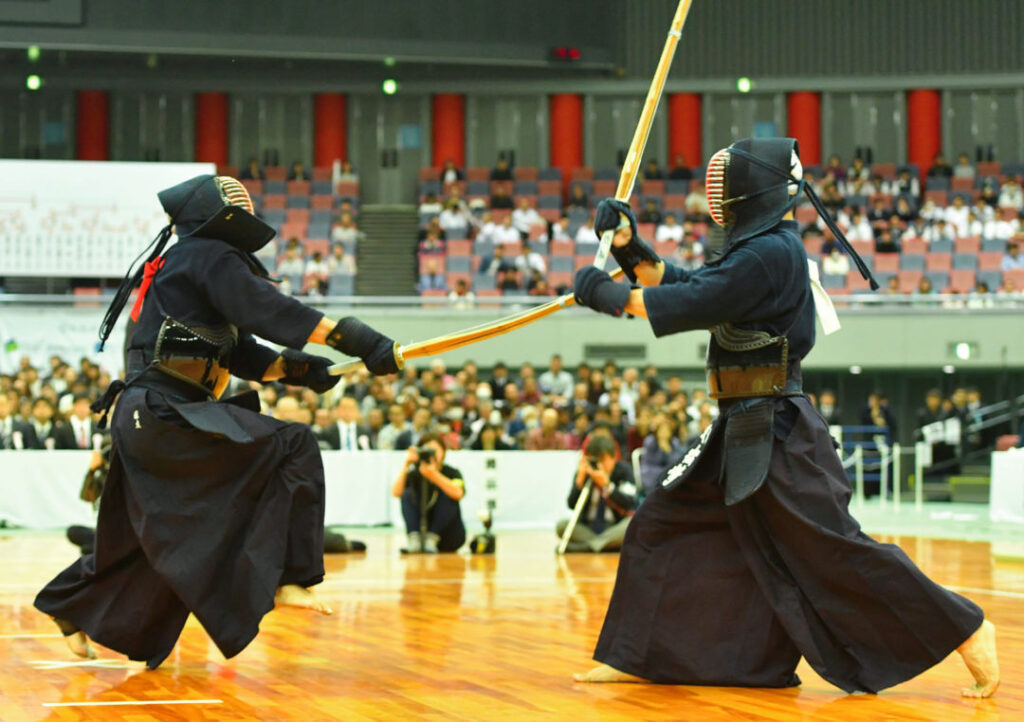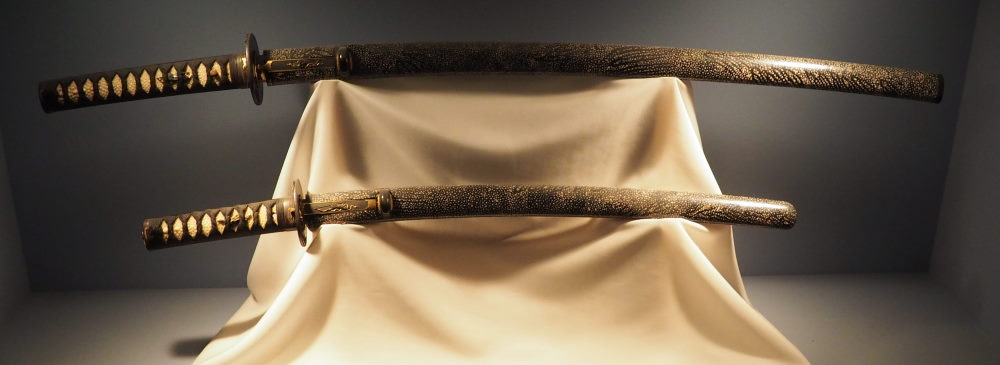Kenjutsu (Japanese: 剣術; 剣 – ken - sword;術 – jutsu – art, technique, skill) is a collective term referring to Japanese sword schools founded before the Meiji Restoration period, i.e. before 1868.
Koryu bujutsu and modern budo
All martial arts schools established before this era of Japanese history are referred to as "old schools" - koryu bujutsu. In contrast, schools established after this period are referred to by the term gendai budo and we include kendo, which comes from kenjutsu, judo derived from jujutsu and iaido derived from iaijutsu. This means that the most popular martial arts (containing the sign in their name -down, meaning "way") are in fact modern systems that have arisen from koryu bujutsu, i.e. old schools. One of the oldest Japanese schools is Tenshin Shōden Katori Shintō-ryū, which gave rise to many other styles, but is also practiced in Japan and around the world (including the TAKE school).
Kenjutsu as a martial art
Broadly speaking, kenjutsu is the Japanese art of swordsmanship, which is internally diverse due to the multitude of schools and traditions. The tradition of kenjutsu or its selected elements has given rise to many modern schools and martial arts, which have transformed and adapted old elements to their needs. It is difficult to talk about kenjutsu without referring to examples of specific sword schools due to the broadness of the term and the time (approximately 600 years) to which it refers.
Kendo was created on the basis of kenjutsu, in which not cuts are performed, but blows with a bamboo sword in places best protected by armor. For a change, in kenjutsu the main targets of attack are places not protected by armor and the joints of armor elements. Although sparring is rarely practiced in kenjutsu schools, it is the basis of kendo practice. You will read more about kendo later.
Kenjutsu practice

Kenjutsu training is primarily the practice of forms, the so-called executioner. However, they are not what many people associate with karate, i.e. "shadow fighting", but a set of attack and defense techniques performed at full pace, always practiced with a partner.
Kenjutsu is also sometimes practiced as part of training tameshigiri, i.e. cutting bamboo mats. Typically, tameshigiri can be seen at shows as a spectacular element of Japanese fencing and a demonstration of the swordsman's skill. Tameshigiri, however, in its essence is a test of the swordsman's cutting technique, a test that requires mastery of the sword and one's own body. A rolled bamboo mat, sometimes additionally soaked, resembles a body in its density, so cutting through it is similar to cutting through an opponent.
Kenjutsu as an element of Tenshin Shōden Katori Shintō-ryu

Tenshin Shōden Katori Shintō-ryu is a school that provided very comprehensive preparation for combat. Kenjutsu is therefore an important element of this school's teaching. The sword in Katori is the first weapon that practitioners learn to wield. The kata of sword techniques in Katori are long, which allows you to learn the techniques very smoothly. Sword practice also provides the basis for subsequent training, many techniques and positions learned during sword training can be easily transferred to other weapons that Katori teaches how to use. The greatest emphasis is placed on the sword, as a versatile and basic weapon for every samurai.
That's why Katori also teaches techniques iaijutsu, i.e. the art of quickly drawing a sword which is practiced using iaito. Since Katori was intended by the founder's master to be a school preparing adepts to fight in combat conditions, the techniques are adapted to fighting in armor, both in terms of movement and cuts made to the most exposed and sensitive points of the opponent. This and the use of bokkens make it impossible to practice full contact fighting, because then each training would result in broken bones, especially in the wrists, which are often the easiest target.
Bokken, Bokuto or Shinai?

Wooden swords are used to practice kenjutsu bokken / Bokuto and fukuroshinai. A bokken is a wooden sword made from a single piece of hardwood - usually red or white oak or hickory. It is durable and heavy, which makes practicing with it most similar to using a real sword. However, training with a bokken requires caution because, as it is a piece of heavy stick, hitting your partner may cause harm. Bokkens are therefore used for practicing kata or suburi, never for contact exercises.
Fukuroshinai is a type of bamboo sword, which is the prototype of the shinai sword used in kendo. Fukuroshinai is made of a repeatedly split piece of bamboo wrapped in leather. Thanks to this construction, the fukuroshinai is both durable and allows for contact training. However, it is used much less frequently than bokken. Most kenjutsu schools do not practice contact fighting or sparring. Steel swords are also used in modern kenjutsu training. For safety and practical reasons, swords, even blunt ones, are not used to practice kata. Practicing kata with a sword would lead to the sword wearing out quickly, chipping or even breaking.
Swords adapted for contact fighting - with appropriate hardness and elasticity of the blade - are much more expensive than swords intended for technique training. The most commonly used swords are iaito type swords with a blunt blade made of a cheaper alloy. They are used to practice iaijutsu or battojutsu, i.e. techniques for quickly drawing a weapon and ending the fight as quickly as possible. Suburi can also be practiced using iaito.
Kenjutsu – not Kendo

Although similar in name, kenjutsu and kendo are significantly different from each other. First of all, kenjutsu is not a sport, because it never was a sport. Historically, it had a very specific application, i.e. learning to wield a sword in basically any situation, on the battlefield, in a duel, on the street or at a banquet. For each of these places, you will find techniques that allow you to effectively defeat your opponent. It was therefore a practical art and important in the life of a samurai.
Meanwhile, kendo is a sport developed based on kenjutsu. A sport in which techniques are focused on competition. We wrote more about it in the article "The Way of the Warrior and Japanese Martial Arts". The goal here is not to defeat the opponent by avoiding wounds, but only to gain points. Kendo is guided by the principles of sports competition, while kenjutsu, which is a direct continuation of old combat traditions, is focused on life and death fighting.
Sword - a symbol, a weapon, a work of art

Mythified by popular culture and literature, the image of warriors in feudal Japan has accustomed us to the image of a proud swordsman marching into battle with a characteristic, slightly curved single-edged sword. Unfortunately, to the detriment of the art discussed here, history does not want to agree with this idea. The main weapon on the battlefields of the Land of the Rising Sun was the bow, most often used from the saddle. The mobility of light cavalry equipped with long-range bows gave a much greater advantage than slow infantry, especially considering the mountainous nature of the Japanese islands. Also when defending or conquering fortifications, the bow turned out to be a more effective weapon.
However, if it was necessary to stand face to face with an opponent on one's own feet, a pole weapon was usually used, naginata (Japanese glaive) or yari (spear), which, due to its greater length and therefore distance from the opponent, provided slightly more safe room for maneuver and mistakes. Also during the Sengoku period, when the battlefield was dominated by Ashigaru light infantry fighting in formations, outside the bow, spears and naginata were used due to the possibility of using them effectively in a tight formation and the ease and lower costs of production.
The sword played a role on the battlefield similar to the gun at the side of a modern soldier, ready to use when necessary, but not being the warrior's main weapon. However, due to its versatility, it became the symbol of the samurai. After all, a sword is a weapon that can be used both in an open field and in a closed room or dense forest, where using a long pole weapon would be impossible. The sword could also be conveniently worn on a daily basis as a symbol of belonging to a caste of warriors - samurai, distinct during the Heian period.
A sword, often with a richly decorated hilt and scabbard, complemented the aristocrat's outfit and was an effective self-defense tool. Many techniques have been preserved to this day among the teachings of various schools (especially technique battojutsu and iaijutsu) are ways to repel an opponent's attack in a street fight, armed only with a sword. It was also an excellent dueling weapon, both because it was carried at the side at all times, but also because the sword's comfort and versatility made it an excellent weapon for fighting a single opponent.
The symbolic importance of the sword increased especially in the Edo period. Due to the lack of wars, the samurai ethos was shaped by literature, art and stories about ancient heroes. Samurai in this period were more bureaucrats or landowners than warriors, but carrying a sword at their belt and practicing kenjutsu connected them with the increasingly established samurai ethos.
It is this mythical self-image of samurai from this period that is most widespread today and perpetuated in popular culture, literature and cinematography. More information about the katana can be found in a separate article: "Katana - samurai sword".
Bibliography
- Miliaresis, Grigoris, Battling the samurai myths: An interview with historian Karl Friday, https://budojapan.com/kenjutsu/20210714kf/
- Friday, Karl F. 2004, Samurai, warfare and the state in early medieval Japan, New York, NY: Routledge.
- Benesch, Oleg. 2016. Inventing the way of the samurai: nationalism, internationalism, and bushidō in modern Japan, Oxfrord, Oxford University Press


